Before heading out on a trip abroad, there are many things that you need to organize. You need to plan your flight, your accommodations, your transport, and how you’re going to pay for it all.
Despite the rise in credit card use and acceptance around the world, the reality is that many countries are still very reliant on cash.
Given this, today, let’s take a look at six of the best ways you can turn your Canadian dollars into physical foreign currencies for your next globetrot to somewhere still running on the paper economy.
In This Post
1. Canada Post
If you’re anything like me, you probably don’t like having to turn your travel plans into a chore, and going to a physical space to pick up a large wad of cash certainly qualifies as a chore in my books.
In addition to being time consuming, it can also sometimes feel a little suspicious walking around with thousands of dollars in strange foreign bills on your person.
å
Plus, to add insult to injury, many of the forex exchanges that run physical brick-and-mortar stores really don’t give you the best bang for your buck.
That’s part of why Canada Post partnered with CIBC back in 2015 to start offering you the convenience of cash delivered to your own home. The Canada Post website offers a very clear and concise picture of exchange rates.
Let’s take a look at a sample of how many US dollars Canada Post will give us for $1,000 (CAD). I consider the US dollar to still be the most versatile individual currency for global travel, and it’s in fact one of the official currencies in stopover-friendly destination Panama City, and in a handful of other countries around the world.
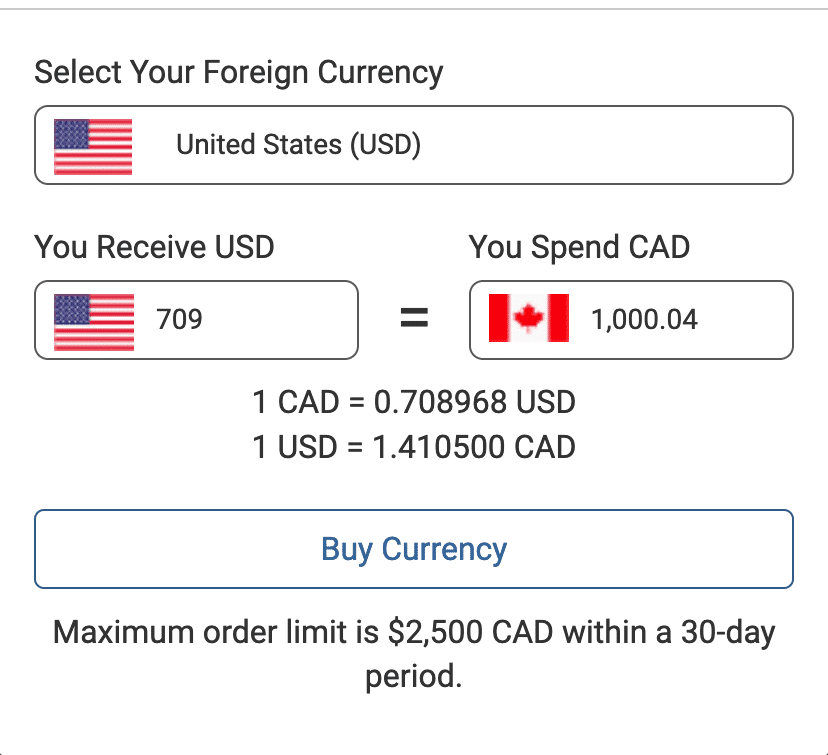
$709 (USD) in cash for our $1,000 (CAD) isn’t terrible by today’s standard, especially when you consider that it’s delivered straight to your front door. Of course, this isn’t as lucrative an option as some of the others we’ll go over on this list, but it’s one of the most convenient and is officially backed and insured by Canada Post itself.
In order to purchase foreign cash via Canada Post, just follow the six steps they outline on their website:
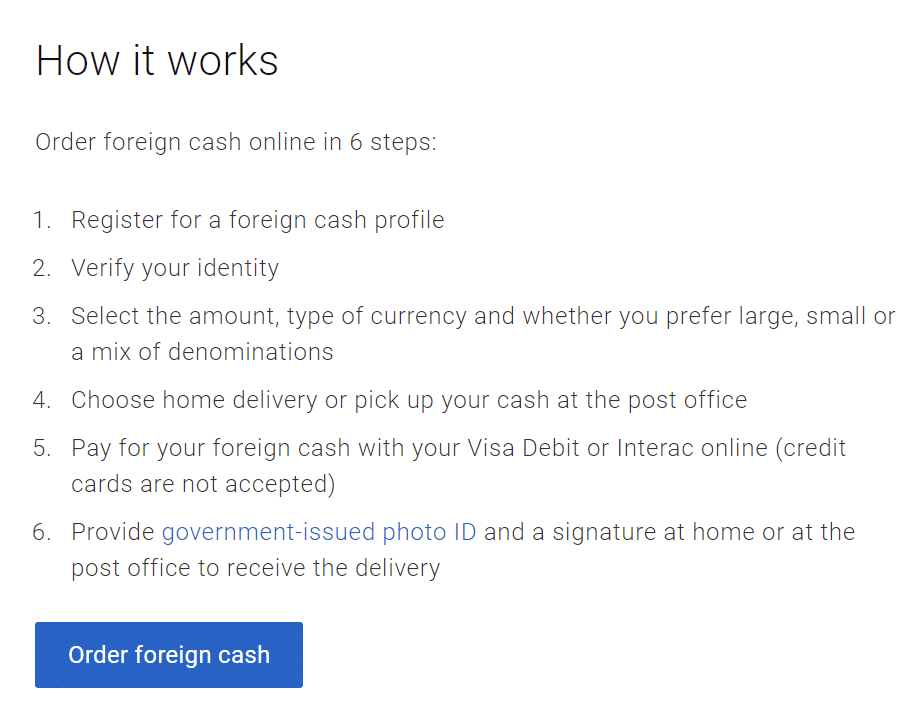
Complete these steps, then pay for your order with either Visa Debit or Interac (credit cards are not accepted). Shipping to your home or local post office is free.
Remember that you’ll have to provide valid government ID either when the delivery arrives or when you get to the post office to physically pick up your cash.
I will note that my critique of this service, aside from it not having the best exchange rates on the market, is that you’re limited to only $2,500 (CAD) worth of foreign cash per 30 days. Still, the convenience of this service is top-notch, making it a great option.
2. Order from an Online Broker
If Canada Post doesn’t cut it for you, then you can always check what foreign exchange rates are available on the open market. This could involve checking with local brick-and-mortar foreign exchanges, but I’m happy to note that in this digital era several businesses have gone online.
Most of these online brokers also offer home delivery, though they are subject to monthly caps on the amount of cash that you can order (presumably in order to prevent money laundering or other unsavoury activity).
There are a few websites that offer this service, but by far the best rates we’ve seen thus far have come from the Toronto-based forex exchange Interchange Financial, so let’s look at what we’ll get for our CAD-to-USD example:

This is quite competitive, standing at about $11 (USD) more than Canada Post’s rate. However, note that Interchange Financial will require any amount of cash you purchase to be divisible by the smallest unit of bills that they have in inventory.
This means that your purchase total will be rounded up to the nearest amount that fits within this requirement.
I think that Interchange Financial is an excellent exchange service, and I’m also thankful that they offer free Canada-wide delivery.
Payment can be made via a Visa Debit card or Interac e-Transfer, and the money purchase limits are the same as Canada Post at $2,500 (CAD) per month.
In case you’re feeling naturally suspicious of dealing with a private online broker, do note that Interchange is fully regulated by FINTRAC. You’ll want to ensure that you do your research on any other online broker before doing business with them.
3. Pick Up at your Favourite Bank
For some folks, shipping large amounts of currency sounds unappealing. What if something goes wrong? On top of that, not everyone is comfortable typing in their Visa debit card number or sending an e-Transfer to a third party when very large quantities of money may be on the line.
In such a situation, or for those of you with preferred exchange rates, the best option may be to exchange your Canadian dollars for foreign currency at your preferred bank.
In fact, most of the Big 5 banks in Canada will have US dollars in stock at your local branch, and they’ll often have euros and pounds sterling as well.
Thus, sometimes an old-school bank will be the most convenient option. But, how do the big banks’ exchange rates stack up?

As we can see here, a canny TD customer could get just a hair below $708 (USD) for their $1,000 (CAD) from their local branch as early as today. That’s not half bad, even if it’s a little below the amounts offered by Canada Post and Interchange Financial.
Naturally, you’ll need to be a TD banking customer to take advantage of this particular rate, and you’ll have to pick up your cash at an eligible bank location; despite these requirements, this is still a solid option.
The money for the exchange will be deducted directly from your bank account, so there’s no need to enter in any Visa debit or Interac information.
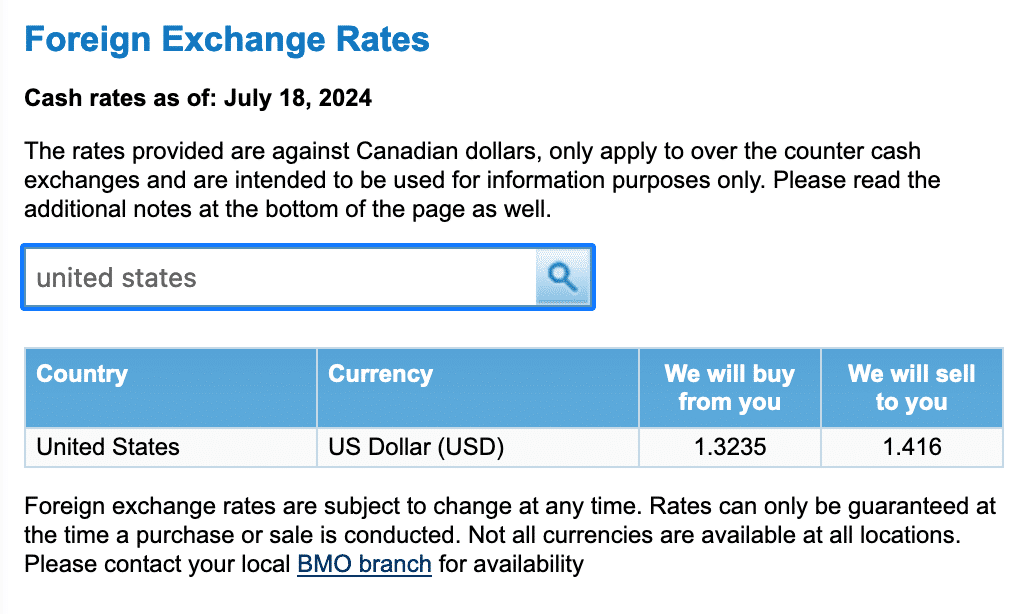
If you choose to go this route, keep in mind that some banks, like BMO, are a bit of a blast from the past and only do foreign exchange in person at the bank.
4. Load a Prepaid Credit Card
For our next two methods for getting foreign hard currency, we’ll be focusing more closely on ATM withdrawals at your destination. Sometimes, it’s a better idea to just get your money on an “as-needed” basis when you’re travelling.
Of course, when you do need cash, you’ll sometimes need quite a bit of it at once. That’s where your travel plans may get frozen in their tracks by the annoying reality of daily withdrawal limits, which can often be quite low – sometimes as little as $500 (CAD) per day.
If you want to avoid carrying too many banknotes at once, but you still want to have the option to load up on them should the need arise, you could consider the Wise debit card.
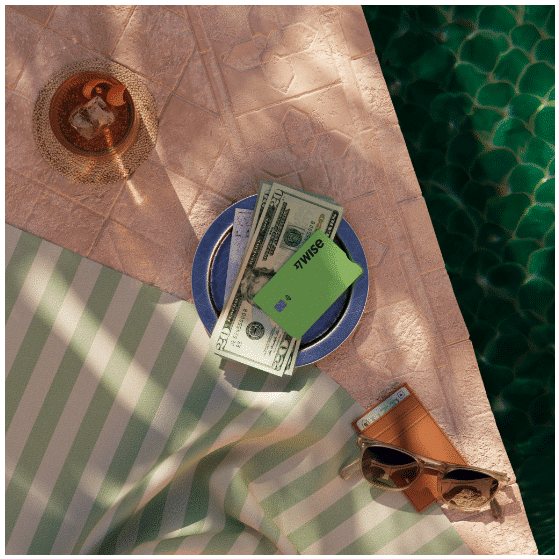
To use this card to withdraw funds at ATMs around the world, you need to have a Wise account, and you need to request the debit card online. You then need to have money loaded into your Wise account.
The appeal of a Wise account is that you can hold multiple currencies at the same time, and these different currencies can be accessed with the debit card.
You can then use your Wise debit card to make purchases in these foreign currencies without incurring any additional fees; however, if you don’t have enough of the foreign currency in your account, Wise will automatically deduct the funds from your account in whichever currency has the lowest conversion fees.
Additionally, you can use your Wise debit card to make withdrawals at local ATMs.
You can take out up to a total of $350 (CAD) per month for free, with the first two ATM withdrawals each month also coming with no fees. After that each ATM withdrawal will cost you $1.50 (CAD), and you will incur a $1.50 (CAD) charge plus 1.75% fee for withdrawals above the first $350 (CAD).
You also want to keep in mind that these fees and charges count towards the $350 (CAD) amount, as does any ATM fee charged by a third-party provider.
Overall, the Wise debit card is a good alternative to hauling around physical currency, particularly if you already use Wise for other foreign currency transactions. The idea of having a single card with multiple currencies available is a proposition made all the more appealing in its ability to help us avoid wearing an appallingly ugly fanny pack.
Another solid prepaid card option is the EQ Bank Card. This card acts as a Mastercard, plus it lets you access your money around the world using ATMs.
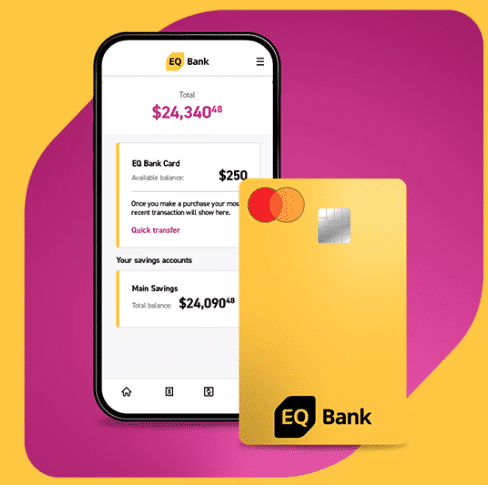
The EQ Bank Card is notable in that it doesn’t charge any foreign transaction fees, and it earns 0.5% cash back on all purchases, both domestic and international.
The card also doesn’t charge any fees for ATM withdrawals. In Canada, EQ Bank will refund any ATM fee you incur when using your prepaid EQ Bank Card, and the bank doesn’t charge any fee when you use an ATM in another country (though you may still be charged an ATM fee by the local bank).
With your EQ Bank Card, you can withdraw up to $500 daily from an ATM, and you can also use the card’s balance for purchases the same way you would use a regular Mastercard.
To get an EQ Bank Card, you need to have an EQ bank account and then you can request a card for free. Once you’ve got the card, you can load up to $10,000 into the card’s account. Notably, this money will continue to earn the same high interest rate (up to 4%) that you earn with your EQ bank account.
This prepaid card option is a great way to budget when you travel since you’re able to deposit a predetermined amount into your card account. The card will also likely save you a bunch of money since you can access your funds without having to pay ridiculous international ATM fees or the usual 2.5% foreign transaction fee that most credit cards charge.
5. Western Union Remittances
Another option to consider if you’re heading to smaller locales where ATMS and money changers are limited (or non-existent), or to a place like Argentina with its Blue Dollar rate, is to send yourself money using Western Union.
When you send yourself money through this process, it can then be picked up at your convenience at any Western Union branch you designate. You should keep in mind that although the amount you remit never expires, it does need to be renewed if it’s not picked up within 90 days.
Sending money through Western Union can be incredibly useful if you’re planning to spend a long period of time in an off-the-beaten path location with no ATMs and where locals already utilize Western Union regularly as a money transfer.
Additionally, for countries like Argentina, which has two exchange rates, Western Union lets you take advantage of the considerably better Blue Dollar rate when sending money, which saves you trying to exchange money in-country (likely at a notably worse exchange rate).
When sending money via Western Union, you may have to pay a fee of up to $7.50 (CAD) depending on how you pay for the funds to be sent. Notably, unlike most of the above options, Western Union does let you pay using a credit card; however, this will likely incur a cash advance fee from your credit card issuer.
6. Fall Back on your Debit Card
When all else fails, you can at least rely on your trusty debit card. So long as you are using an ATM at a reputable financial institution and not a dingy back-alley bar, the spot conversion rate will almost always beat out local currency dealers, even if you have to pay an obnoxious foreign ATM fee.
However, said fees are not always a requirement. Canadian financial institutions are often present in the strangest of places. Scotiabank, for example, has ample presence in Latin America and the Caribbean, and also has a series of reciprocal agreements with other banks which will allow you to use their ATMs without fear of banking fees.
Similarly, the other Big 5 banks often have similar treaties with international institutions, and so you can rest easy using your domestic debit cards overseas should the need arise.
While I personally would prefer to have the cash on me should I require it, there’s nothing wrong with taking out money at your destination via your debit card if that’s more your style.
Conclusion
As exciting as travel is, it can also be a time fraught with stress, not least of which is the concern of “how will I pay for stuff at my destination?” This is an issue that can feel doubly serious when flying to a country where credit card acceptance is not at Canadian levels.
I hope that today I’ve helped you find a few ways to save your money by securing excellent exchange rates for the cash you need to make the most of your voyages.
Until next time, keep your bills uncreased.









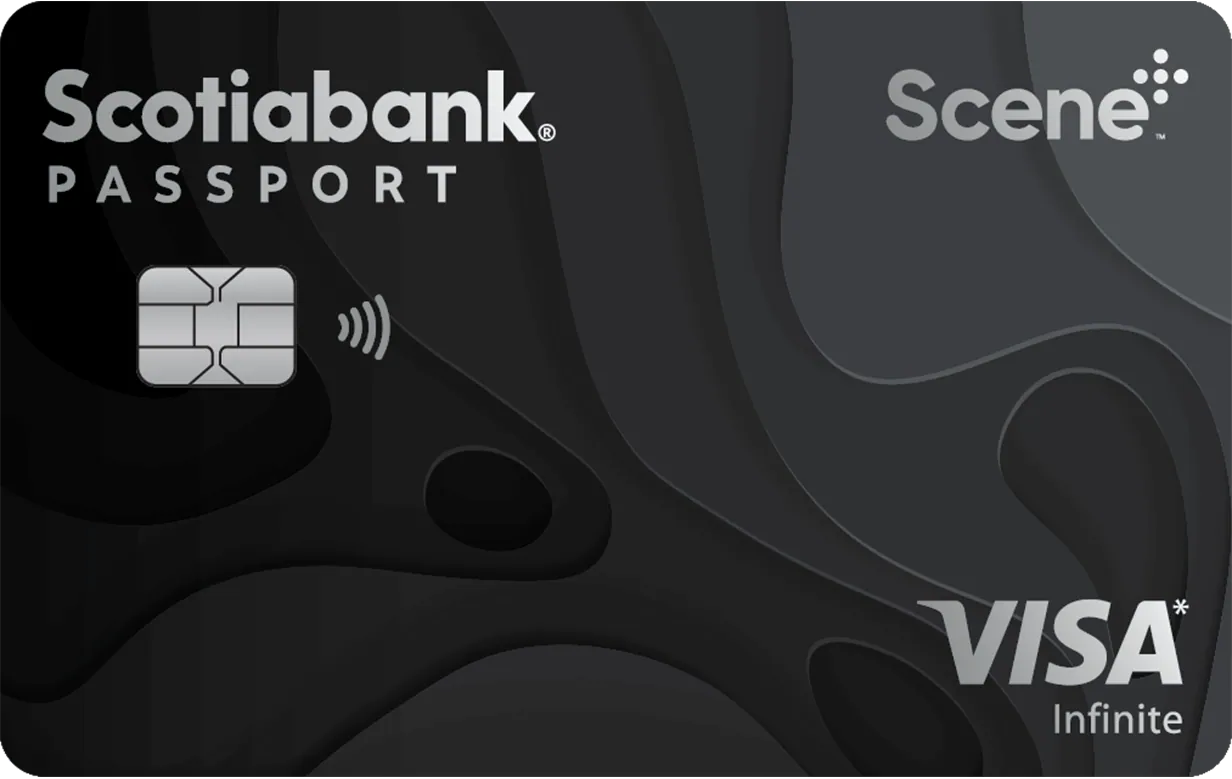






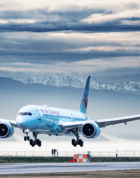



Do I understand it correctly from all of the above? As of June 2022, the best and probably only option is to get a no fee, no FX charge card and cash advance your trip?
( you prepaid your withdrawals by putting money on your card)
If I am likely to go back to a country, I keep the excess currency. I would rather do that and avoid paying FX to convert to Cdn and then FX to convert back in the future. In a low interest environment, the cost of holding the money is minimal and I am prepared to live with future changes in FX rates, be they positive or negative. If not going back, I try and exchange at the departing airport; for some of the less commonly traded currencies trading may not be available in Canada, or if so, the cost can be prohibitive. Smaller change I leave as hotel tip.
I tried Interchange Financial recently based on something I read on this forum. To AB took about 10d. Our Post person was on holiday which led to another one doing an unfamiliar route and not finding our house, which led to a reroute to the post office. I was tracking the package so managed to pick it up soon after (hence the 10d). If you relied on the Canada Post Parcel notification, it would have extended the time period to 14d. I was a little concerned with that wad of cash floating around Canada Post Nebula but it got to me. Moral is to order WELL in advance of the trip and get a tracking number. I would still use Interchange in the future, just wish I wasn’t limited by the $2000 Canadian maximum.
Any suggestions on what to do with excess local currency at the end of your trip? I’ve got many Ziploc bags with coins and bills from past countries traveled to, and keeping them until the next visit to that destination seems inefficient.
Several airlines will give out a United Way envelopes and collect it en-route as a donation for all that loose change. I know Cathay Pacific, Eva and Malaysian airlines used to do that not sure their policy with COVID. Sometimes I also look for “donation bins” at international airports for similar causes.
this is a subject close to my heart as I find FX fees are unconscionable. US$ aren’t as big a problem as less traded currencies – e.g. you would take a huge haircut on Thai baht at your local bank and would do much better changing your money in Thailand (perhaps the airport). On the other hand I’ve found the Canadian banks give you a better rate on Euro’s than European airports. Depending on where I’m going I sometimes take the C$ with me and trade on arrival. Some bank accounts provide preferential exchange rates for select accounts or customers and waive withdrawal fees on foreign withdrawals. I have used the ATM withdrawal method extensively as the rates are very close to spot. A 5$ foreign fee, and a waived Canadian fee on a $2,000 withdrawal is peanuts. Works best when you have a fixed travel location and can go from SD box in room to ATM and back to SD box in short order, and only withdrawing subsequently from your stash on an as needed basis rather than doing multiple transactions. I did have my accounts frozen about 25 years ago and I also recently went to about 50 ATM’s in Cuba and couldn’t find one that would process a Canadian withdrawal (that was a trip with an unintended tight budget!) I’m intrigued by the idea of preloading a credit card although it wouldn’t have helped in Cuba, and if it’s a card you don’t normally use, I could see there’d be a risk of bank freezing
Don’t use your Debit Card outside Canada, ever. Overpay a credit card or two (not the cards you’re spending from during your trip, separate ones just for cash withdrawals) and withdraw as needed. You can keep funding the credit cards as you go, from your Online Banking. VISA cash withdrawal costs $5 so on a three week trip with 6 such transactions I’m out CAD$30. You won’t be charged cash advance interest as long as you maintain the overpaid balances. Benefits: No third party transactions described above, no waiting time for anything, no waiting at home for delivery, no queue at a post office. Never do the most dangerous thing in the world: expose your debit card to a machine outside Canada. How many of you know that if your debit card is frozen by the overzealous Fraud department of the bank (just using it in a foreign country can make them freak out), you’ll be locked out of your Online Banking? AND that you can’t get it unlocked from abroad! Don’t take my word for it, ask your bank “how can I get Online Banking and debit card restored to use if it’s locked by Fraud department?” You’ll have no Online Banking and no working debit card until you visit a branch, in person, inside Canada. They don’t make exceptions and all the calls in the world to their call centre won’t solve it. Another reason to never use your debit card outside Canada, ever ever: If money goes missing from your bank accounts you have to persuade the bank to return your money to you. But if rogue charges appear on your VISA/Mastercard, the bank first asks you for the money, then gives up when you show you didn’t sign for them. Just overpay a credit card or two, withdraw at ATMs, make sure they always stay overpaid (to prevent “cash advance” interest charges) and you’ll enjoy maximum convenience, safety and value.
It’s also worth remembering that the Credit Card companies accept liability for fraudulent charges. But fraudulent withdrawals made with your bank card is the responsibility of the card holder.
There are pros and cons for everything. I have used ATMs overseas in the past 25 years of travelling over 40+ countries and never had any issues. Try using ATM machine while the bank is in business.
Using credit cards to withdraw funds overseas is safer but will cost very high currency exchange fees.
I have an upcoming trip booked to India in January 2023 and Interchange Financial is even cheaper than currency exchanges in Vancouver that have a high volume of transactions with Indian Rupees.
Thanks for the tip!